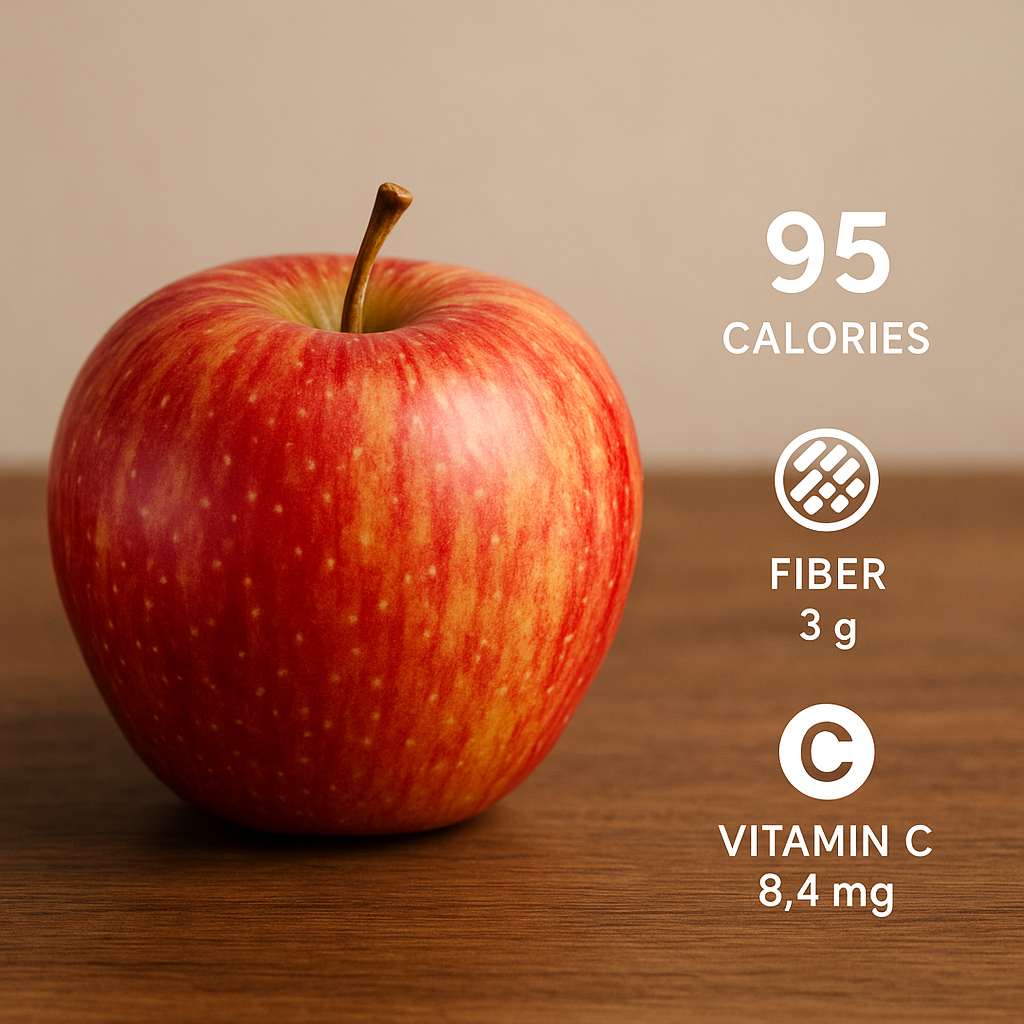Disclaimer
This article is for informational purposes only. Nutritional values are approximate and can vary by apple size and growing conditions. Always consult a healthcare or nutrition professional for personalized dietary guidance.
Crisp, mildly sweet, and wonderfully aromatic, the Gala apple is one of the most popular apple varieties worldwide. Whether eaten raw, sliced into salads, or blended into smoothies, this apple offers both flavor and nutrition.
But what exactly makes it healthy? From its low-calorie count to its vitamin and antioxidant content, understanding Gala apple nutrition can help you appreciate why it’s more than just a tasty snack.
This article breaks down the nutritional value of Gala apples, explores their health benefits, and shows how they compare with other apple varieties.
What Is a Gala Apple?
The Gala apple originated in New Zealand in the 1930s, created by crossing Kidd’s Orange Red and Golden Delicious apples. Its distinctive orange-red skin with yellow streaks and mild sweetness make it ideal for both eating raw and cooking.
Today, it’s one of the most widely available apples in grocery stores — known for its low acidity, high juiciness, and pleasant crunch.
Its composition makes it suitable for people who prefer a lighter, less tart fruit than varieties like Granny Smith or Honeycrisp.
Gala Apple Nutrition Data (Per 1 Medium Apple – Approx. 182 g)
| Nutrient | Amount |
|---|---|
| Calories | 95 kcal |
| Total Carbohydrates | 25 g |
| Sugars | 19 g |
| Dietary Fiber | 3 g |
| Protein | 0.5 g |
| Total Fat | 0.3 g |
| Saturated Fat | 0.05 g |
| Sodium | 2 mg |
| Potassium | 195 mg |
| Vitamin C | 8.4 mg (9% DV) |
| Vitamin A | 3 µg |
| Calcium | 11 mg |
| Iron | 0.2 mg |
| Magnesium | 9 mg |
| Water Content | ~86% |
DV = Daily Value based on a 2,000-calorie diet.
Calories in Gala Apples
A medium Gala apple contains about 95 calories, almost all from natural carbohydrates.
It’s an ideal snack for anyone watching calorie intake — nutrient-dense yet light. Because of its high water and fiber content, it provides satiety without excess calories.
For comparison:
- Honeycrisp Apple: 104 kcal
- Fuji Apple: 110 kcal
- Granny Smith Apple: 90 kcal
The Gala’s calorie content sits comfortably in the middle range, offering sweetness without heaviness.
Carbohydrates and Sugar
Each Gala apple provides around 25 grams of carbohydrates, mostly from natural sugars like fructose, glucose, and sucrose.
While this may seem high, these sugars are balanced by 3 grams of fiber, which slows digestion and prevents blood sugar spikes.
With a glycemic index (GI) of about 38–40, Gala apples are considered low GI, meaning they provide a steady energy release rather than rapid sugar surges.
Fiber Content and Digestive Benefits
Gala apples are an excellent source of dietary fiber, primarily pectin, a type of soluble fiber known for:
- Promoting digestive regularity
- Supporting gut-friendly bacteria
- Reducing LDL (bad) cholesterol levels
- Enhancing fullness and appetite control
One Gala apple provides about 12% of the daily fiber recommendation for women and 9% for men.
To get the full benefit, eat the skin — that’s where most of the fiber resides.
Vitamins in Gala Apples
Gala apples contain several essential vitamins that support overall health:
1. Vitamin C:
Each apple provides about 8.4 mg (9% DV) of vitamin C, an antioxidant that boosts immune health, collagen formation, and iron absorption.
2. Vitamin A:
Contributes to healthy skin, eyes, and cell growth.
3. B Vitamins:
Small amounts of B-complex vitamins like B1 (thiamine), B2 (riboflavin), and B6 support energy metabolism.
4. Vitamin K:
Trace amounts assist in blood clotting and bone health.
Minerals in Gala Apples
| Mineral | Function | Amount per Medium Apple |
|---|---|---|
| Potassium | Maintains blood pressure and heart rhythm | 195 mg |
| Calcium | Supports bone and tooth structure | 11 mg |
| Magnesium | Aids in nerve and muscle function | 9 mg |
| Iron | Helps transport oxygen in the blood | 0.2 mg |
| Phosphorus | Strengthens bones and teeth | 20 mg |
Potassium is the standout — it helps counteract sodium’s effects, promoting heart and muscle health.
Fat and Protein
Gala apples are virtually fat-free and low in protein, containing less than 0.5 grams of each per serving.
Their main nutritional contribution lies in carbohydrates, fiber, vitamins, and antioxidants — making them an excellent complement to higher-protein or high-fat foods like nuts, cheese, or yogurt.
Antioxidants and Phytochemicals
Gala apples are rich in polyphenols, powerful antioxidants concentrated in the peel. These compounds help neutralize harmful free radicals that cause oxidative stress.
Key phytochemicals include:
- Quercetin: Anti-inflammatory and immune-supportive
- Catechin: Promotes heart and brain health
- Chlorogenic acid: Aids glucose metabolism
- Phloridzin: Unique to apples, helps regulate blood sugar absorption
Eating the apple with the skin can double the antioxidant intake compared to peeled apples.
Hydration and Electrolytes
With about 86% water content, Gala apples are naturally hydrating. Combined with potassium, they help balance electrolytes and support fluid retention — especially beneficial after exercise or during warm weather.
Gala Apples and Weight Management
Gala apples are among the best natural snacks for weight control due to their combination of fiber, volume, and low calories.
They provide a high satiety-to-calorie ratio, meaning you feel fuller with fewer calories. Studies show that people who eat apples before meals tend to consume 15–20% fewer calories overall.
Pairing them with protein (like peanut butter or Greek yogurt) enhances satisfaction further.
Blood Sugar Control and Diabetes
Despite their natural sugar content, Gala apples are diabetes-friendly due to their fiber and polyphenol content.
The pectin fiber slows sugar absorption, and the polyphenols help the body use insulin more effectively.
To further stabilize blood sugar:
- Eat apples with the skin
- Pair with a protein source
- Choose whole apples over juice
Heart Health Benefits
Regular apple consumption is linked to improved heart health. The combination of fiber, potassium, and antioxidants supports cardiovascular function by:
- Lowering LDL cholesterol
- Reducing blood pressure
- Protecting arteries from oxidative damage
One medium Gala apple a day can contribute to better lipid balance and overall heart wellness.
Digestive and Gut Health
Gala apples act as prebiotics, feeding good gut bacteria.
The pectin fiber enhances the growth of beneficial microbes like Bifidobacteria, which:
- Improve digestion
- Enhance nutrient absorption
- Strengthen the immune system
A healthy gut also influences mental health and weight stability, making apples a foundational food for long-term well-being.
Gala Apple vs Other Varieties
| Variety | Calories | Sugar | Fiber | Vitamin C | Taste |
|---|---|---|---|---|---|
| Gala | 95 kcal | 19 g | 3 g | 8.4 mg | Sweet, mild |
| Honeycrisp | 104 kcal | 21 g | 3.3 g | 9 mg | Crisp, sweet-tart |
| Fuji | 110 kcal | 22 g | 2.8 g | 8 mg | Very sweet |
| Granny Smith | 90 kcal | 16 g | 4 g | 7 mg | Tart |
| Red Delicious | 95 kcal | 19 g | 3 g | 6 mg | Sweet, mellow |
Gala apples rank high in flavor, moderate in sugar, and provide a balanced nutritional profile suitable for everyday eating.
How to Add Gala Apples to Your Diet
- Eat raw: The simplest way to enjoy it and preserve nutrients.
- Add to salads: Combine with walnuts, greens, and feta for crunch and sweetness.
- Blend into smoothies: Pairs well with spinach, oats, and almond milk.
- Bake or roast: Naturally caramelizes for a healthy dessert.
- Serve with nut butter: A balanced snack with healthy fats and protein.
- Add to oatmeal or yogurt: For fiber and natural sweetness.
Avoid peeling when possible — most antioxidants and fiber reside in the skin.
Selecting and Storing Gala Apples
- Choose firm apples with bright, streaked red-orange skin.
- Avoid soft spots or dull, waxy surfaces.
- Store in the refrigerator’s crisper drawer — they remain fresh for up to 6 weeks.
- Rinse thoroughly before eating to remove residues.
For best flavor, let the apple reach room temperature before eating.
Fun Facts About Gala Apples
- Developed in New Zealand and introduced to the U.S. in the 1970s.
- The name “Gala” signifies celebration and delight.
- It’s one of the top-selling apple varieties globally due to its consistent sweetness.
- Rich in natural aroma compounds that make it taste fresher than many other apples.
Potential Downsides
While Gala apples are extremely healthy, a few points are worth noting:
- Natural sugars: At 19 g per apple, moderation is important for low-carb diets.
- Pesticide exposure: Apples often appear on the “Dirty Dozen” list — consider washing or buying organic.
- Digestive sensitivity: High fiber may cause mild gas in some individuals.
These concerns are minor for most people and easily managed with variety and moderation.
Quick Recap of Gala Apple Nutrition
| Nutrient | Value per Medium Apple |
|---|---|
| Calories | 95 kcal |
| Carbohydrates | 25 g |
| Sugars | 19 g |
| Fiber | 3 g |
| Protein | 0.5 g |
| Fat | 0.3 g |
| Potassium | 195 mg |
| Vitamin C | 8.4 mg |
| Water Content | ~86% |
The Bottom Line
The Gala apple is a balanced, nutrient-rich fruit that offers natural sweetness, hydration, and essential micronutrients — all at under 100 calories.
Its high fiber content supports digestion, its antioxidants protect against oxidative stress, and its potassium helps maintain heart health. Whether eaten raw or added to meals, it’s an easy, everyday choice for a healthy diet.
Simple, sweet, and satisfying — the Gala apple truly proves that the best nutrition often comes from the simplest foods.

